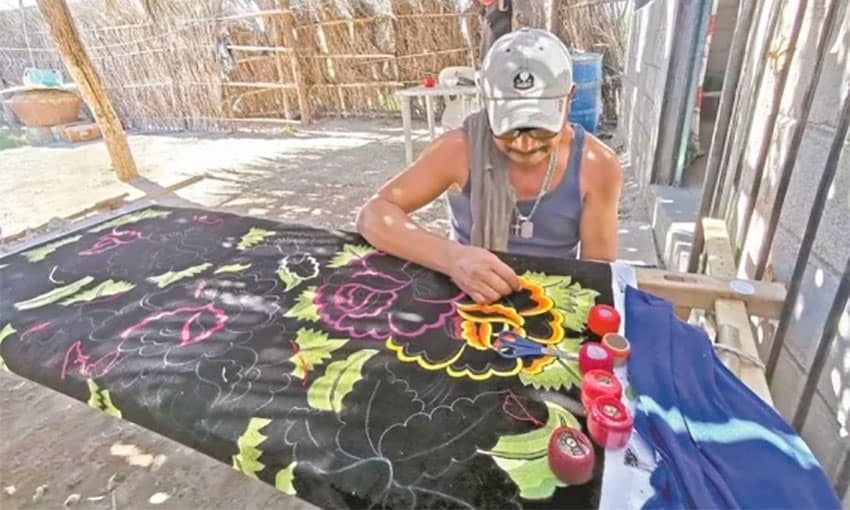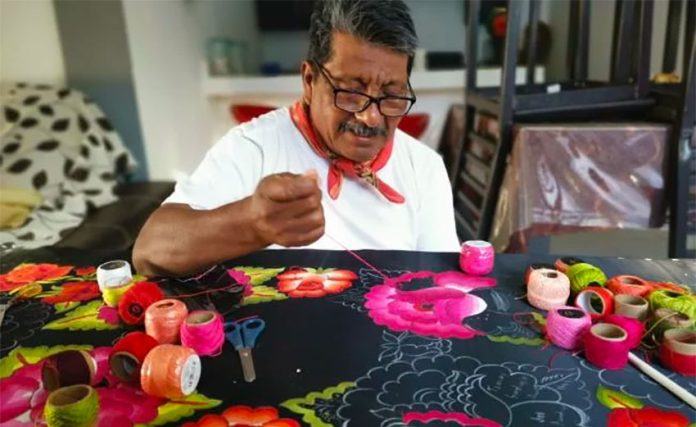Those of a certain age remember when football player Rosey Grier “came out” as a needleworker in the 1970s. It made a sensation at the time and while he didn’t make embroidery cool for men per se, his size and fierce reputation on the gridiron made most people think twice before making fun of it and him.
In Grier’s case, needlework was therapeutic; in particular, it helped him with his fear of flying. In Mexico, decorating cloth with colored thread is an economic activity still, carried out by women to earn supplementary income for the family.
However, there are cases where the economic value of embroidered goods is sufficient that male family members participate, mostly older men who choose to do it or those who are unable to do more traditional men’s work.
But there are a few places where the income generated by embroidery is enough to change the culture, at least on a local level, and put men to work. That is the case in Santa Rosa de Lima in the Isthmus region of Oaxaca.
Over the past 27 years, Gerardo Gallegos Talín is one of those men. He has perfected his techniques and designs, becoming one of the town’s foremost experts on traditional Isthmus Zapotec embroidery. He, like most other artisans, works at his craft part time, also earning income as a laborer in construction. His time is split about half and half between the two occupations.

He started young, at age 20, learning from female family members out of economic necessity when work was scarce. This situation is common enough in Santa Rosa that nearly all the men know how to embroider, and many boys are now learning.
“To be an embroiderer in Santa Rosa is not a woman’s thing, it is nothing more than an economic thing,” Gallegos explains while concentrating on the panel he is working on.
It is a very different situation here than in other communities in the Isthmus such as Juchitán or Ixtaltepec. Despite having similar economic problems, embroidery is still considered women’s work. The only exception to this rule in these communities is with the Muxe, men who dress as women and are treated as such.
Other men in those communities would be ridiculed for doing embroidery, but this is not the case in Santa Rosa. No one considers a man any less a man simply because he knows how to combine colors and stitches well. “Here it is a characteristic of the town and its people. We work as a team with our women and our children. It is family work,” Gallegos asserts.
Some of their pieces represent months of work. A large involved piece may cost about 3,000 pesos in materials but can fetch anywhere from 10,000 to 27,000 pesos (US $530 to $1,430) depending on the quality and intricacy.
Another well-known embroiderer is Rubén Ramírez López, more commonly known as Ta Finu. He has spent 59 of his 72 years embroidering, starting when he was only 13. He is completely self-taught, and took years to develop his craft.
When he began, only 10 men were embroidering, but today over 100 now do so in Santa Rosa and some are doing it full time.
While the men of Santa Rosa are more than aware of attitudes towards embroidering in general, it does not bother Ta Finu or the others because the work allows them to make a living and provide for their children.
“Sure there is some ridicule, but we ignore it. To be an embroiderer is neither easy nor frivolous work. On the contrary, it is very difficult and hard on the eyes and spine.”
Ta Finu and his family work together to produce about 20 traditional outfits with embroidery per year, usually finishing each in a month and a half. They sell their work to clients in various states, often through social media. Many of their clients have been with them for years.
In Ta Finu’s case, the embroidery is profitable enough that other work is done only when there isn’t enough embroidery, not the other way around.
Source: El Universal (sp)
